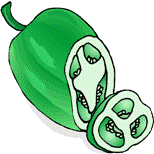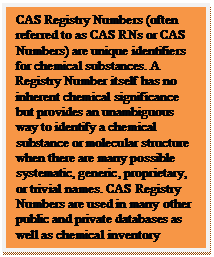Chemical Agent Instructor
| Home | • | Contact | • | Cardiff Pines | • | Tear Gas Expert | • | Tear Gas Resource |
OC, VP, PAVA, WHAT DOES IT ALL MEAN?
We have seen a new chemical emerge onto the law enforcement and personal protection market. This new chemical will be used in non-lethal and less lethal aerosols and impact devices.
Do we need to be afraid of it? Will it be effective? Will it kill people? These are the question we all will all be asking as it hits the market. The short answer is: No more than the chemicals we are using today.
To understand the newest chemical we need to first understand how pepper sprays or Oleoresin Capsicum (OC) work. Oleoresin Capsicum is a blend (oleo) of oils (resins) taken from pepper (capsicum) plants. These oils are extracted, and then dried and granulized for use in self defense products. The oil is a blend of several different compounds. Each of the compounds is called capsaicinoids.
 Capsaicinoid is the compound that causes a burning sensation and inflammation of the mucous membranes. Each of the six major capsaicinoids in OC triggers a unique burning sensation. The capsaicinoids are: Capsaicin, Pelargonylvanillylamide, Dihydrocapsaicin, Nordihydrocapsaicin, Homodihydrocapsaicin, and Homocapsaicin.
Capsaicinoid is the compound that causes a burning sensation and inflammation of the mucous membranes. Each of the six major capsaicinoids in OC triggers a unique burning sensation. The capsaicinoids are: Capsaicin, Pelargonylvanillylamide, Dihydrocapsaicin, Nordihydrocapsaicin, Homodihydrocapsaicin, and Homocapsaicin.
Capsaicin and Pelargonylvanillylamide are the “hottest” of the capsaicinoids and are equal in “heat”. The other capsaicinoids have significantly less “heat“ associated with them. Pelargonylvanillylamide, is also known as “VP”, Nonivamide, Capsaicin II, Synthetic capsaicin, and PAVA. Capsaicin or Pelargonylvanillylamide is the compound that generates the spiciness in chili peppers and the burning sensation in pepper sprays.
When you hear people refer to chemical sprays that are 5% or 10% OC it doesn’t mean much when measuring the heat level of the spray. The effectiveness of pepper spray is related to the amount of capsaicinoid in each burst not the percentage within the canister.
Another measure of effectiveness is the Scoville Heat Unit (SHU). The process by which SHU’s are calculated is known as the Scoville Organoleptic Test. In this test, participants taste a chili sample and subjectively record its heat level. Samples are then diluted until the taster can no longer detect heat; this dilution is called the Scoville Heat Unit.
The amount and type of capsaicinoid within an OC spray is calculated using the High Performance Liquid Chromatography (HPLC) method. The “VP” compound is so similar to capsaicin that the standard HPLC test cannot distinguish it from the capsaicin.
However, this test alone will not distinguish between Capsaicin and “VP” the two hottest capsaicinoids.To decipher Capsaicin from “VP” a Gas Chromatography Mass Spectrometer (GC-MS) test must be performed. A GC-MS test calculates the amount of compounds in parts per million (ppm). A quick conversion from HPLC to Scoville is to multiply the ppm by 15 to get the Scoville Heat  Unit.
Unit.
Using the more sophisticated GC-MS test scientists discovered “VP” compound in oleoresin capsicum. The “VP” compound is so similar to capsaicin that the standard HPLC test didn’t distinguish it from the capsaicin. “VP” has one carbon less in its chemical structure than capsaicin. “VP” compound can be extracted from OC just like capsaicin can be extracted. “VP” is also present in plants other than peppers and can be extracted from those sources.
“VP” has earned the title of synthetic capsaicin because like Capsaicin it can also be produced in a laboratory. It has also been named capsaicin II because of its similarity to capsaicin. The EPA has recently given “VP” its own Chemical Abstracts Service (CAS) Registry Number 2444-46-4.
Typical OC aerosol sprays have 0.50% capsaicinoids and 0.18% capsaicin by weight.
The degree of “heat” is dependant upon the percentage of the six capsaicinoids within the canister.
The following chart illustrates how the average percentage of capsaicinoid within the mixture relates to the overall Relative Heat level.
|
% of mixture |
Heat Level |
Relative Heat |
Capsaicin |
0.18% |
100 |
18 |
“VP” |
0.01% |
100 |
1 |
Dihydrocapsaicin |
0.02% |
75 |
1.5 |
Nordihydrocapsaicin |
0.04% |
50 |
2 |
Homodihydrocapsaicin |
0.11% |
25 |
2.5 |
Homocapsaicin |
0.14% |
25 |
3.5 |
Total |
0.50% |
|
28.5 |
In this example the typical product would have a heat level of 28.5. The amount of the compound mixture in the pepper will vary based upon the type of pepper, the climate it was grown in and how healthy the plant was. If you made your mixture with all Capsaicin or “VP” your relative heat level would be: 100 or almost three and one half times as hot as the typical existing OC.
| “VP” or capsaicin | 1.0% |
100 |
100 |
There are no specific medical studies done using “VP” as a self-defense spray. However, “VP” is chemically the same as OC. It affects the human body exactly the same way. The studies that have been done in the past with OC can be extended to “VP”. We know from extensive use documented by the California Department of Justice that the level of OC in today’s sprays will affect approximately 86% of the people that law enforcement officers contact.
Why doesn’t everyone use “VP” or pure capsaicin in his or her products? The simple answer is that VP is more expensive.
We do know that OC in its current configuration does not affect approximately14% of the population we contact. Will this new chemical that is three and a half times hotter affect a larger percentage of the population? Only time will tell.
Glossary
Capsicum |
Common peppers |
Oleoresin Capsicum |
The extract of the dried ripe fruits of peppers. It contains a complex mixture of essential oils, waxes, dried, colored organic cellulose materials, and several capsaicinoids. |
Capsaicinoids |
The pungent components of peppers. They encompass at least 6 major compounds: Capsaicin, Dihydrocapsaicin, Nordihydrocapsaicin, Homodihydrocapsaicin, Homocapsaicin, and Pelargonylvanillylamide. |
Capsaicin |
A colorless, crystalline, bitter compound present in capsicum. The amount varies depending on the species and crop year of pepper. Heat level is equal to “VP”. Both are the hottest of the capsaicinoids. |
Capsaicin II |
Another term for “VP” |
Nonimivide |
Another term for “VP” |
Pelargonylvanillylamide (“VP”) |
Discovered in 1911, “VP” is a purified natural compound found in pepper plants. Is as hot as Capsaicin but can be extracted from other naturally occurring sources. |
PAVA |
Another name for “VP”. |
HPLC and GC/MS |
High Performance Liquid Chromatography and Gas Chromatography / Mass Spectrometry are two of the standard chemical analysis methods to scientifically determine the concentration of compounds such as Capsaicin and Pelargonylvanillylamide in chemical agent compounds and sprays. |
Scoville Heat Units (SHU)
|
SHU testing is a "tongue" tasting to determine the heat level of the spice by a panel of 5 individuals. The test is not accurate since it depends on the individual taste sensitivity that changes from person to person and does not measure the actual chemical percentage within the product. |
Synthetic Capsaicin |
Another term for “VP” |
Back
If you have any questions please go to the contacts page and contact Dennis Cole.